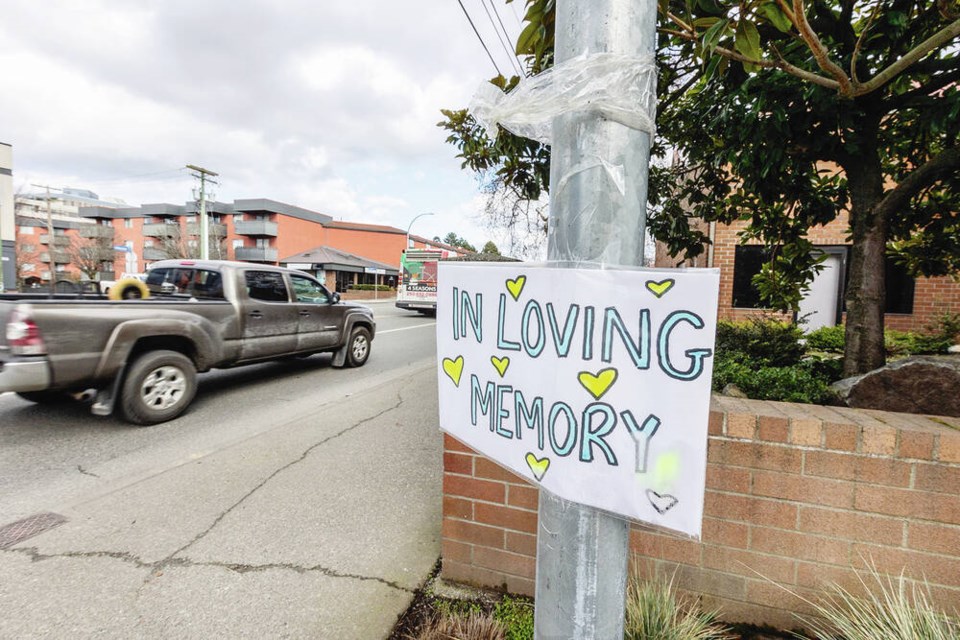The past couple of weeks have not been good ones for pedestrians on Vancouver Island. From Sooke to Cedar to Victoria and Saanich, there have been a string of fatal and serious-injury pedestrian incidents on our roads in recent days.
It’s not just happening here, either. Last year in the U.S., a record 7,508 people were killed by vehicles — an increase of 77% since 2010. Twenty pedestrians were killed every day last year in the U.S.
In sa国际传媒, by proportion, we’re doing quite a bit better, but it’s still nothing to be proud about. Statistics sa国际传媒 says that on average, 300 pedestrians were killed in this country each year between 2018 and 2020.
At the risk of stating the obvious, most pedestrians are struck when they enter the roadway. In sa国际传媒, 21 per cent of all pedestrians are struck crossing at an intersection. What happens when a human object comes into contact with a vehicle weighing anywhere from 1,100 to 2,500 kilos isn’t pretty.
The most common injuries emergency-room doctors tackle after a severe pedestrian collision are head injuries — concussions, skull fractures, hemorrhages and intracranial swelling.
Lower-body injuries are also likely, including hip and pelvis fractures, leg fractures, abrasions and torn ligaments.
Wrapping up this macabre list are torso injuries, which are more likely to occur when a pedestrian is struck by a larger vehicle. They include smashed rib cages along with internal-organ ruptures, which can be fatal themselves if not treated right away.
I don’t like highlighting gory details, but the message has to get out that we’re facing a serious plight on our streets right now. People are dying and they’re dying from incidents that are almost always preventable.
We’re in one of the worst weather periods drivers can face on the road. March brings on sheets of rain followed by clear periods of brilliant sunshine, making visibility a major challenge. Around one in five pedestrian deaths occur as a result of poor visibility caused by weather.
It’s not surprising that around 20% of the drivers who have fatally struck a pedestrian were impaired either by alcohol or drugs.
What may be a little more surprising is that the intoxication rate is about the same for pedestrians who are killed. Manoeuvring around busy streets in 2024 requires constant attention and judgment — the very things that alcohol and drugs rob from you.
Distracted driving continues to be a serious problem, as well. A car travelling at 50 km/h covers nearly 14 metres in one second, meaning that in the three seconds you might take to switch music tracks or pick up that cellphone on the seat next to you, you have travelled nearly half the length of a soccer field.
Vehicles turning left at an intersection create an especially dangerous moment for pedestrians. Drivers focusing on road traffic often experience tunnel vision trying to make that turn before the light changes and miss pedestrians crossing in front of them.
Intersections are the place on the road where most driving incidents occur — pedestrians or not. They require 100% of your attention.
Pedestrians who ignore signals and cross at places other than intersections raise their risk of being struck exponentially, especially on arterial roads where driving speeds are usually higher, lane changes are more frequent and driver visibility is reduced simply based on the congestion around them.
So pedestrians have to pitch in on this problem as well. Disobeying walk signals is pretty much an epidemic in the CRD. Too many pedestrians must stop assuming that drivers are always paying attention as they walk out into the street. These past few weeks should tell you otherwise. Make eye contact with an approaching driver before stepping out.
Never assume that because a car in one lane has stopped for you in a crosswalk that the driver in the lane beside him is going to stop as well.
Young pedestrians are also more vulnerable to being hit by vehicles, according to the Traffic Injury Research Foundation of sa国际传媒.
Its survey showed that 57% of people ages 16 to 24 admitted to jaywalking, compared to 38% for the rest of the population. The same survey found that 57% of young people also said they are plugged into headphones near public streets, compared to 26% of all other age groups.
I’m often accused of blaming pedestrians too much for these problems. Maybe. But according to the Traffic Injury Research Foundation, pedestrians are 284 times more likely to be injured or killed in a collision than other road users.
With a stat like that, who’s “right” or “wrong” in these tragic moments is pretty much irrelevant.



